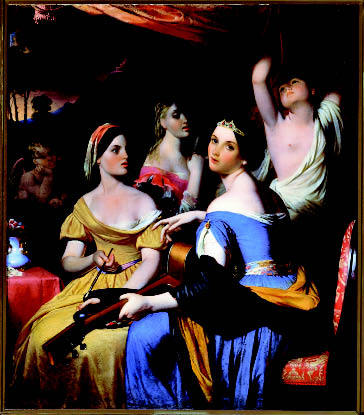Who was the first American to marry an English duke? Most students of the peerage would say it was Consuelo Yzagna who married the eldest son of the Duke of Manchester in 1876. But the banjo-strumming Cuban American Consuelo was not the first Yankee duchess. As early as 1828 the American Louisa Caton married the eldest son of the Duke of Leeds. This was half a century before the dollar princesses, trading titles for cash, played havoc with Burke’s Peerage. Louisa and her sisters were the pioneers of the American invasion of London society. Their conquest was so successful, and they became so assimilated, that they left barely a ripple. Only now has Jehanne Wake researched and pieced together their story.
The four Caton sisters were born into one of the grandest American families. Their grandfather, Charles Carroll, lived to become a national treasure: he was the last survivor of the Founding Fathers who signed the Declaration of Independence. The head of an Irish Catholic family, Carroll owned huge tobacco plantations scattered over Maryland which brought stupendous wealth. The Caton girls were proud of their revolutionary inheritance, but their family fortune depended on slavery. Rather as one might give a child a dog, each of the little Caton girls owned a body slave, who remained hers for life.
In their twenties, three of the four sisters travelled to England in 1816. They brought an introduction to the Duke of Wellington, who took an instant fancy to them, and especially to the eldest, Marianne. They were lionised by society. Trailing along behind the Duke, they attended parties at Almacks, stayed in big houses, visited the Prince Regent’s court at Brighton and travelled to post-Napoleonic France.
The Duke of Wellington’s patronage was crucial. He fell ‘madly in love’ with Marianne — according to Jehanne Wake, she was the love of his life. Marianne happened to be already married to a dull and difficult American (oddly enough, her sister-in-law had been briefly married to Jerome Bonaparte). The Duke commissioned Lawrence to paint portraits both of him and Marianne. The portrait of Marianne hung always in his study. When her sister Louisa wanted to marry the one-armed war hero, Felton Bathurst Hervey, the Duke overcame the furious resistance of his family, who were aghast at this mesalliance with a Yankee, whom they saw as a savage adventuress.
Marianne’s tiresome husband died conveniently young, and shortly after she married Lord Wellesley, the Duke of Wellington’s older brother. Wellesley was Viceroy of Ireland, so Marianne had to hold court in Dublin, which she did with great dignity, in spite of being a Catholic and a republican. So good was she at court behaviour that she became one of Queen Adelaide’s favourite ladies-in-waiting. Wellesley, however, turned out to be rather a disappointment. Thirty years older than her, he was unreliable and bad-tempered. He had no money, and he depended entirely on Marianne’s funds. Louisa, who was also widowed young, made a brilliant second marriage to Lord Carmarthen, the eldest son of the Duke of Leeds. His parents were furious about this blot on the family escutcheon, but when Louisa eventually became the first American duchess, she was a great success.
The Caton sisters’ triumph was not simply a matter of charm and beauty, though they possessed both in abundance. They were also clever with money. In contrast with the aristocracy of Regency England, who enjoyed a culture of indebtedness, the Caton sisters understood how to manage inherited wealth. Bess, the third sister, was a dedicated lady speculator, with a passion for investing. Jehanne Wake first came across the sisters when she found a letter from Bess in Baring’s archive, ordering stock purchases, something which women just didn’t do in 1830s England. She is especially good on Bess’s speculations. Picking up tips from her friends the Rothschilds and the Barings, Bess invested her own and her sisters’ money with a skill and assurance that very few English women possess even today.
Of the four sisters, three were childless. Neither Marianne nor Louisa was able to produce heirs for their husbands, a sadness which Wake attributes to the mercury that was prescribed for their childhood ailments. The only sister to have children was Emily, who married a wealthy Scots Canadian fur trader named MacTavish, and stayed behind on the family plantation.
Jehanne Wake has skilfully constructed the Catons’ story from their letters. Her book vividly paints a fascinating picture of a transatlantic world where rich women could achieve extraordinary social power by sticking with their sisters and being shrewd with their money.






Comments